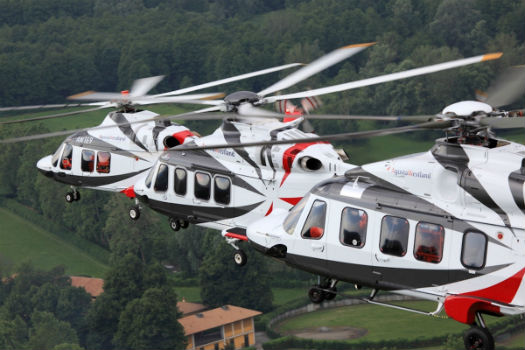
A large order of AgustaWestland’s family of helicopters — the AW139, AW169 and AW189 — helped spark Lease Corporation International’s 2012 entry into helicopter leasing. AgustaWestland Photo
Lease Corporation International’s 2012 decision to pursue helicopter leasing in addition to its portfolio of fixed-wing aircraft has placed the company in prime position to reap the benefits of a more than $3.5-billion market that could triple in five years. LCI’s fleet of delivered and on order helicopters is approaching 90, securing its spot among the major players such as Milestone Aviation Group and Waypoint Leasing, in a segment that has rapidly expanded to include existing names and new entrants such as Amur Helicopter Financial Services, Arrow Leasing, Era Helicopters, GE Capital Aviation Services (which announced plans to acquire Milestone in October), and Infinity Helicopter Leasing.
CEO Michael Platt told Vertical that there are currently nine helicopters through LCI agreements in service as of mid-November. Deliveries will continue to build momentum, with 10 to 12 completed by the end of 2014.
“After January, there’s over 75 aircraft in our backlog,” he explained. “So that’s aircraft that have been ordered or we have options from AgustaWestland and Airbus Helicopters, plus some additional helicopters that will be doing either pre-sale leasebacks, or other means such as alignments or purchase orders.”
Every week or two, he continued, LCI comes across additional possibilities. Over a five-year period through 2019, Platt anticipates adding new contracts and accelerating existing agreements: “We see significant demand in a variety of areas,” he said. “Oil-and-gas is one. We’re seeing significant demand in HEMS and search-and-rescue, and we’re finding other areas that we hadn’t really focused on initially — things like offshore wind and other additional markets opening up.”
According to Platt, a $325-million asset-backed warehouse credit facility that closed Oct. 1 — which carries an option for another $100 million — gives LCI the ability to react quickly to the needs of customers. “It allows us to place helicopters opportunistically much closer to deliveries,” he said. “Our finance team led by CFO Jaspal Jandu did an excellent job and have made our life much easier. It makes our business much more flexible.”
A $400-million order for AgustaWestland AW139s, AW169s and AW189s served to kick-start LCI’s involvement with helicopter leasing in February 2012. Executive chairman Crispin Maunder remarked at the time that the company decided to enter the helicopter market after “the culmination of careful analysis and observation of this sector.”
Platt echoed that statement, noting that LCI “saw an industry where the banks were sort of backing away from the traditional bank finance leasing, and there was a gap in the market.” The company also observed a “huge replacement cycle with older aircraft being replaced with new aircraft, and those new aircraft are much more expensive than previously.” He added that with helicopters becoming more expensive, many operators are becoming more focused on the finance side of their business and the efficient use of capital. One example of a growing trend of financial management is the appointment of Bristow CEO Jonathan Baliff, replacing William Chiles, who retired in early 2014. Baliff previously served as chief financial officer for Bristow, and before that was a Wall Street investment banker, Platt pointed out.
“That trend of financial management is permeating the helicopter operator business, starting with the biggest guys, but it’s working its way down, where people are trying to reconcile their balance sheets as efficiently as possible and get returns on their investment capital,” he said. “Leaving money sitting around in assets for years and years may not be the best use of those resources.”
LCI’s order book also includes the Airbus Helicopters EC175, and the company is a launch customer for the EC225e. The gameplan is to work with Bell, Sikorsky and other manufacturers going forward. “We need to further engage with both,” Platt said of Bell and Sikorsky, whether through direct purchase or sale-leasebacks. “We’re a big fan of the S-92 in particular, and we’re looking for ways to acquire some. On the Bell side, the 525 is going to be an exciting helicopter and we’re waiting to see how that market develops,” he added, also noting opportunities with the sale-leaseback of Bell 412s.
Platt explained that having additional leasing and financing options gives operators more flexibility. “There are a lot of smaller operators that just don’t have the capability to buy $20-millon helicopters on their balance sheet, and therefore they couldn’t compete in certain tenders,” he said. “But now they can lease those helicopters, so they know exactly what those costs are.” Another effect is removing the need to speculate on helicopters. “They’re busy operating helicopters,” he continued. “They aren’t required to have these large order books, where they don’t know whether or not they’re actually going to need those helicopters.”









